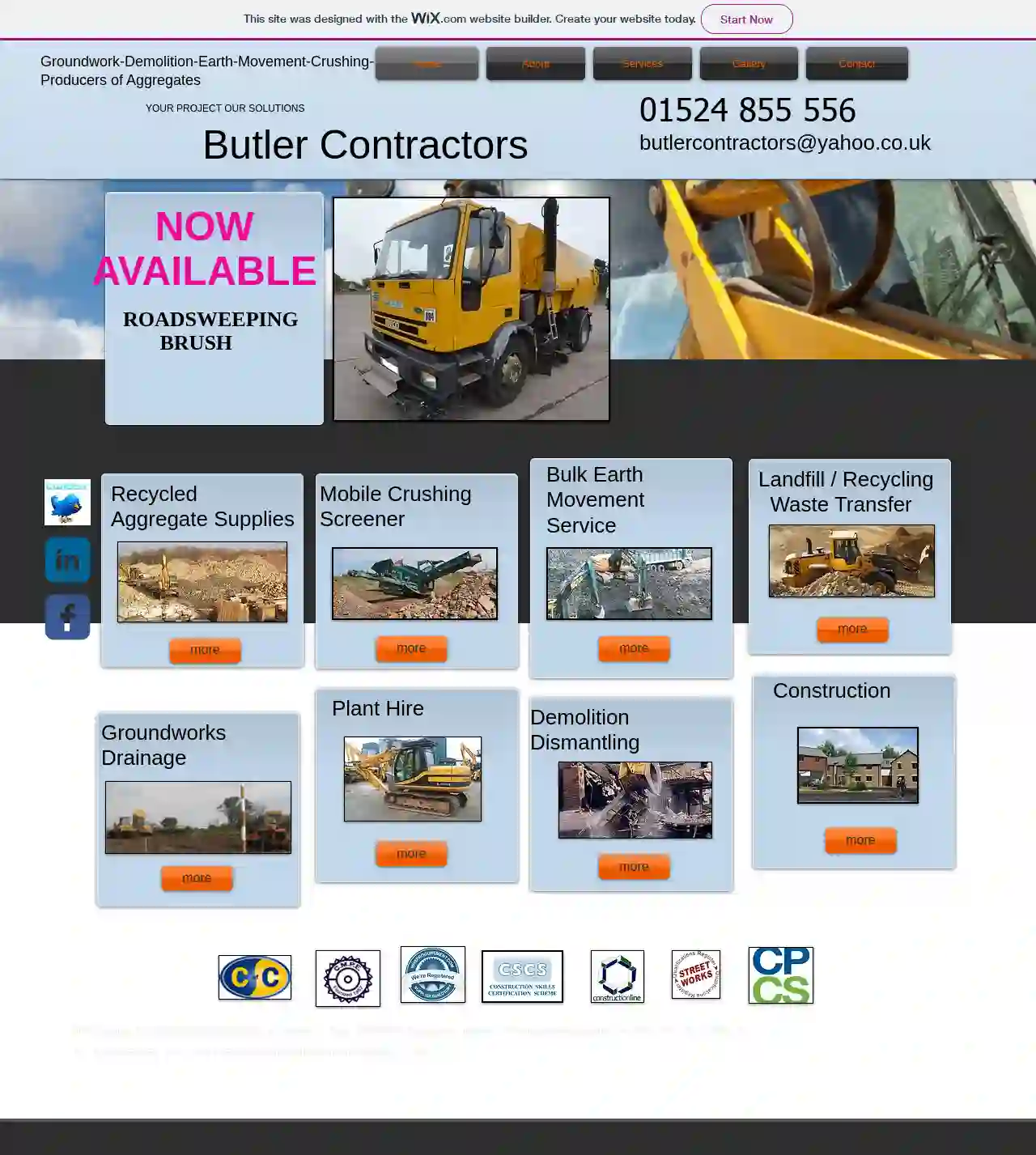Excavation Contractors Frodsham
Find Land Excavation in Frodsham
Get up to 3 Excavation Contractor quotes for your project today! Compare profiles, reviews, accreditations, portfolio, etc... and choose the best service.

Ground Structures Ltd
53 reviewsWinterbourne Farm, Provender Lane, Norton, Faversham, ME13 0ST, GBGround Structures: Your Foundation for Success Ground Structures is a well-established groundwork and construction company with over 15 years of experience. Our dedicated team has built a strong reputation for delivering high-quality, competitive solutions across a wide range of projects. We understand that our team is the heart of our business, and we are committed to building lasting relationships with our commercial clients. We have a proven track record of successfully completing projects ranging from £5,000 to £1 million in various sectors, including commercial, industrial, social housing, and educational facilities. Our commitment to excellence ensures that we deliver projects on time and within budget, exceeding client expectations. At Ground Structures, we are passionate about providing comprehensive groundwork and construction solutions. Our services encompass infrastructure, sub-structure, foundations, drainage, and external works. We are dedicated to delivering projects that meet the highest safety standards, utilizing our own machinery and ensuring our team is fully certified and trained. We are proud to partner with large construction companies who recognize our expertise in civil engineering and groundworks. Our commitment to deadlines and efficiency makes us the preferred choice for construction companies seeking reliable and experienced groundwork specialists. We ensure that the foundations of your projects are completed on time and within budget, allowing for seamless development from the ground up. Our business is your business. We are dedicated to providing exceptional service and building long-term partnerships with our clients.
- Services
- Why Us?
- Gallery
Get Quote
Metro Rod
Ashwood Court, Tytherington Business Park, Macclesfield, Cheshire, SK10 2XF, GBMetro Rod: Your Trusted Drainage Experts Metro Rod is the UK's leading drainage company, providing professional and reliable services for both businesses and homes. With over 40 locally-based teams across the UK, we offer the most comprehensive drainage solutions, exceptional customer service, and the fastest response times. Whether you're facing a drainage emergency, a recurring problem, or simply need routine maintenance, our team of highly qualified engineers is here to help. We understand that drainage issues can be disruptive and stressful. That's why we're committed to providing a seamless and efficient service, from the initial consultation to the final solution. Our team is equipped with the latest technology and expertise to handle any drainage challenge, no matter how complex or challenging. At Metro Rod, we pride ourselves on our commitment to customer satisfaction. We go the extra mile to ensure that our clients are happy with our work and that their drainage systems are functioning properly. We also offer a range of services to help prevent future problems, such as regular maintenance and inspections.
- Services
- Why Us?
- Accreditations
- Gallery
Get Quote
Chevron Traffic Management | Winchester
3.831 reviews141-149 Salisbury House, London Wall, 141-149 Salisbury House London Wall, London, EC2M 5QQ, GBAbout Chevron TM Chevron TM provides physical and digital traffic controls to ensure your works are carried out safely and your workers and the general public are safe. We manage traffic for organisations working within Utilities, Construction, Rail, High-Speed Network, Local Authorities and Events which need to disrupt normal traffic flow to complete a project. Why Choose Us We believe our employees are the best in our business. They are ambitious, hard-working, dedicated and are proud to work for Chevron TM. We are proud of them and the contribution they make to the success of our company and to ensuring that we are the UK’s leading independent traffic management company.
- Services
- Why Us?
- Gallery
Get Quote
Brixet Build Ltd
Flat 9, 31 Lombard Grove, Manchester, M14 6BE, GBAbout us Brixet Build Ltd is a reputable construction company located in Manchester. With over 20 years of experience in building trade, we follow a systematic approach from concept to completion to provide the best service to our clients. We undertake construction work for projects of all sizes. From sewers and drainage to maintenance work and concreting, you can count on us for a complete service. We specialise in extensions but carry out all aspects of building work. To have a detailed discussion with our professionals, get in touch with us and we will be happy to help you. Quality workmanship We are a team of experienced and skilled builders who are committed to providing high-quality workmanship. We use only the best materials and techniques to ensure that your project is completed to the highest standards. 20 years' experience We have over 20 years of experience in the building industry. This means that we have the knowledge and expertise to handle any project, no matter how big or small. Fully insured We are fully insured, so you can rest assured that your project is in safe hands. We are committed to providing our clients with peace of mind.
- Services
- Why Us?
- Gallery
Get Quote
Pre-Construct Archaeology Winchester
51 reviewsThe Granary, Rectory Farm, Pampisford, Cambridgeshire, Cambridge, CB22 3EN, GBPre-Construct Archaeology (PCA) is a well-established independent archaeological company specializing in high-quality, client-focused heritage initiatives. PCA provides the full range of archaeological and built heritage services in all public and private sectors, such as property development, transport, and renewable energy. We are able to undertake work anywhere in the UK, including contaminated sites. PCA undertakes projects of all sizes in many diverse sectors. We have worked on major infrastructure projects encompassing several large-scale investigations, and in notable locations such as Westminster Abbey and King’s Cross Central. With offices in Cambridge, Durham, London, Newark, Norwich, Warwick, and Winchester, we can help with your heritage requirements. Get in touch with Pre-Construct Archaeology in your local area or contact our general enquiries for advice.
- Services
- Why Us?
- Testimonials
- Gallery
Get Quote
Butler Contractors
3.73 reviews95 King Street, Lancaster, 95 King Street Lancaster, LA1 1RH, GBButler Contractors Groundwork-Demolition-Earth-Movement-Crushing- Producers of Aggregates YOUR PROJECT OUR SOLUTIONS
- Services
- Why Us?
- Gallery
Get Quote
O'neill construction & excavating LLC
Chester, GBAbout O'Neill Construction Family owned and operated, our team has completed a wide variety of projects including commercial, residential homes, and industrial facilities. We pride ourselves on our attention to detail and commitment to customer satisfaction.
- Services
- Why Us?
- Gallery
Get Quote- Br
Brock’s Lawn, Landscape and Excavation
51 reviews[ADDRESS LINE 1], [ADDRESS LINE 2], [STREET ADDRESS], [CITY], [POST CODE], GBAbout Brocks Lawn and Landscape Brocks Lawn and Landscape is a locally owned and operated business dedicated to providing high-quality lawn care and landscaping services to the [CITY] area. We are committed to exceeding our clients' expectations with our professional and reliable services. Our team of experienced professionals is passionate about creating beautiful and functional outdoor spaces that enhance the beauty of your property. We offer a wide range of services to meet your specific needs, including: Lawn mowing Edging Trimming Fertilization Weed control Aeration Landscaping design and installation And more! At Brocks Lawn and Landscape, we believe in building strong relationships with our clients. We are dedicated to providing exceptional customer service and ensuring your complete satisfaction. Contact us today for a free estimate and let us help you create the outdoor oasis of your dreams.
- Services
- Why Us?
Get Quote 
Budget Maintenance Ltd
4.429 reviews6 Oak Street, Ellesmere Port, Cheshire, CH65 2AS, GBReliance Bathrooms Reliance Bathrooms is part of Budget Maintenance Ltd. Their team has been installing and designing bathrooms since 2000 and they excel in the bathroom design and installation market. With 100 years combined plumbing experience, the team’s wealth of experience and knowledge in this area is extensive, and the quality of their work is outstanding. Gas Services Budget Maintenance Ltd offers a comprehensive range of gas services, including servicing of gas appliances, central heating installation, natural gas and LPG, boiler installations, flue liners, solid fuel & natural gas, and Landlords gas safety certificates. Drainage Budget Maintenance Ltd provides a wide range of drainage services, including drainage replacement, internal and external household drainage, and guttering. All underground drainage replacement work comes with a 12 month labour warrant. Plumbing Budget Maintenance Ltd offers a comprehensive range of plumbing services, including beautiful bathrooms/wetrooms, flushing of heating systems, cylinders, tanks & pipeworks, all plumbing repairs, sinks, radiators, taps & toilets, showers, electricity, and pumped systems.
- Services
- Why Us?
- Gallery
Get Quote
Stoke Design & planning
Chester, GBWelcome to Stoke Design & Planning We deal with all aspects of planning permission and building regulations. We are a leading Staffordshire Company for the provision of Architectural Building Plans for all Extensions, Loft / Garage Conversions, Disability Adaptations, Changes of use and New Homes. Please feel free to call 07894 467750
- Services
- Why Us?
- Gallery
Get Quote
Over 13,059+ Excavation Businesses in our network
Our excavation contractors operate in Frodsham & surrounding areas!
ExcavationHQ has curated and vetted the Best Excavation Contractors in Frodsham. Find the most trustworthy business today.
Frequently Asked Questions About Excavation Contractors
- Determining Soil Suitability: Assessing whether the soil can support the intended structure or load.
- Recommending Foundation Types: Advising on the appropriate foundation design based on soil characteristics.
- Addressing Drainage and Erosion Issues: Providing solutions to manage water runoff and prevent erosion.
- Evaluating Slope Stability: Assessing the risk of landslides or soil movement on slopes.
- Building on challenging soil types (expansive clay, loose sand, etc.)
- Constructing large or complex structures
- Excavating near slopes or retaining walls
- Addressing drainage or erosion concerns
- Experience: Choose contractors with a proven track record and years of experience in excavation projects similar to yours.
- Licensing and Insurance: Verify that they are properly licensed to operate in your area and carry adequate insurance to protect you from liability in case of accidents or damage.
- Equipment and Resources: Ensure they have the necessary equipment and resources to handle your project efficiently and safely.
- Positive Reviews and References: Check online reviews and testimonials from previous customers. Request references and contact them to inquire about their experience with the contractor.
- Professionalism: Opt for a company that communicates clearly, provides detailed and transparent estimates, and has a responsive and courteous team.
- Clear the Area: Remove any obstacles, including vehicles, outdoor furniture, landscaping features, or structures, from the excavation zone and surrounding area.
- Mark Existing Features: Identify and mark underground utilities, septic tanks, sprinkler systems, or other buried elements you want to protect.
- Protect Landscaping: Use tarps or fencing to shield trees, shrubs, gardens, or other landscaping elements from damage.
- Provide Access: Ensure the excavation contractor has clear access to the work area, including gates wide enough for equipment.
- Discuss Logistics: Coordinate with the contractor regarding parking arrangements, material delivery, and any special instructions or concerns you might have.
- Determine the Area: Measure the length and width of the area you want to fill. Multiply them to get the area in square feet (or meters).
- Determine the Depth: Measure the difference between the existing grade and the desired grade (how much you need to raise the ground). This is the depth of fill required.
- Calculate Volume: Multiply the area (step 1) by the depth (step 2) to get the volume in cubic feet (or meters).
- Account for Compaction: Fill dirt compacts when it settles, so add 10% to 25% to the calculated volume to account for compaction. The exact percentage depends on the type of fill material.
What is a soil engineer, and do I need one?
How do I find a good excavation contractor?
How do I prepare my property for excavation?
How do I calculate how much dirt I need for fill?
What is a soil engineer, and do I need one?
- Determining Soil Suitability: Assessing whether the soil can support the intended structure or load.
- Recommending Foundation Types: Advising on the appropriate foundation design based on soil characteristics.
- Addressing Drainage and Erosion Issues: Providing solutions to manage water runoff and prevent erosion.
- Evaluating Slope Stability: Assessing the risk of landslides or soil movement on slopes.
- Building on challenging soil types (expansive clay, loose sand, etc.)
- Constructing large or complex structures
- Excavating near slopes or retaining walls
- Addressing drainage or erosion concerns
How do I find a good excavation contractor?
- Experience: Choose contractors with a proven track record and years of experience in excavation projects similar to yours.
- Licensing and Insurance: Verify that they are properly licensed to operate in your area and carry adequate insurance to protect you from liability in case of accidents or damage.
- Equipment and Resources: Ensure they have the necessary equipment and resources to handle your project efficiently and safely.
- Positive Reviews and References: Check online reviews and testimonials from previous customers. Request references and contact them to inquire about their experience with the contractor.
- Professionalism: Opt for a company that communicates clearly, provides detailed and transparent estimates, and has a responsive and courteous team.
How do I prepare my property for excavation?
- Clear the Area: Remove any obstacles, including vehicles, outdoor furniture, landscaping features, or structures, from the excavation zone and surrounding area.
- Mark Existing Features: Identify and mark underground utilities, septic tanks, sprinkler systems, or other buried elements you want to protect.
- Protect Landscaping: Use tarps or fencing to shield trees, shrubs, gardens, or other landscaping elements from damage.
- Provide Access: Ensure the excavation contractor has clear access to the work area, including gates wide enough for equipment.
- Discuss Logistics: Coordinate with the contractor regarding parking arrangements, material delivery, and any special instructions or concerns you might have.
How do I calculate how much dirt I need for fill?
- Determine the Area: Measure the length and width of the area you want to fill. Multiply them to get the area in square feet (or meters).
- Determine the Depth: Measure the difference between the existing grade and the desired grade (how much you need to raise the ground). This is the depth of fill required.
- Calculate Volume: Multiply the area (step 1) by the depth (step 2) to get the volume in cubic feet (or meters).
- Account for Compaction: Fill dirt compacts when it settles, so add 10% to 25% to the calculated volume to account for compaction. The exact percentage depends on the type of fill material.